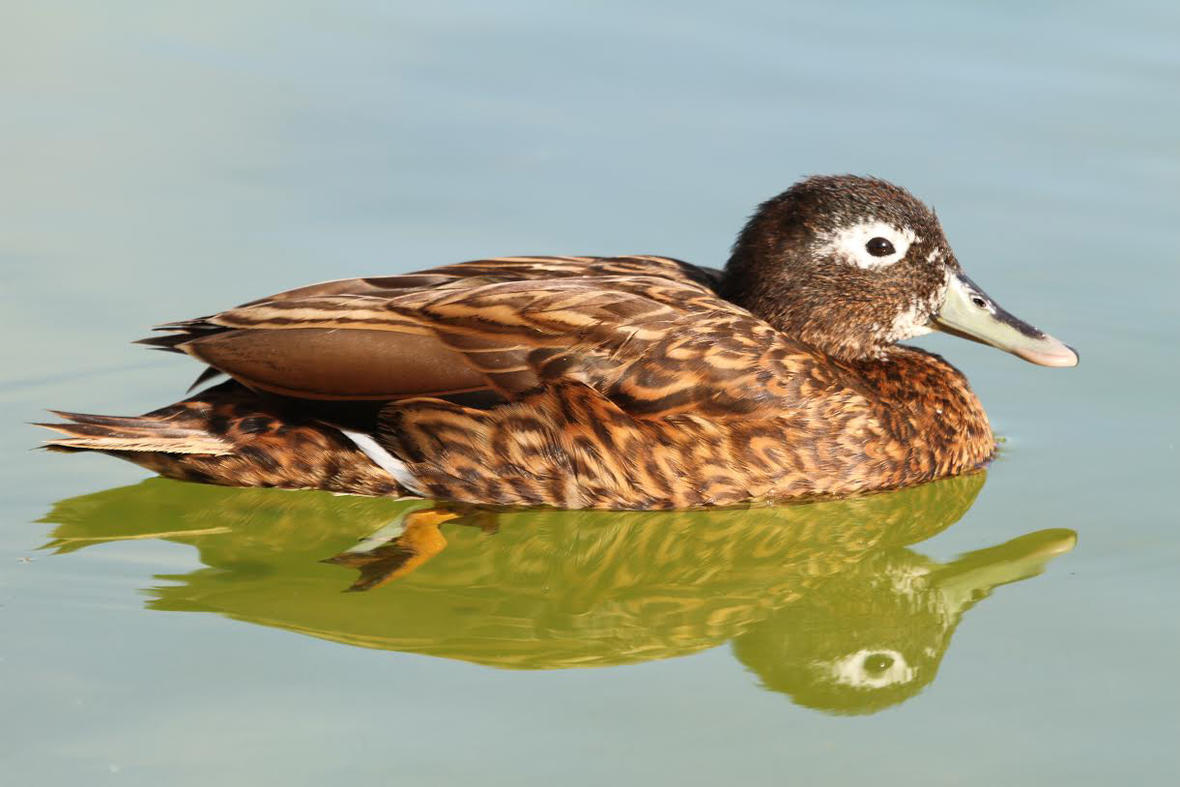
Laysan duck (Anas laysanensis)
Species name
- Dutch name:
- Laysan taling
- English name:
- Laysan duck
- German name:
- Laysanente
- French name:
- Canard de Laysan
- Scientific name:
- Anas laysanensis
Scientific classification
- Order:
- Anseriformes
- Family:
- Anatidae
- Onderfamilie:
- Anatinae
- Genus:
- Anas
Description
- Description:
Male:
Male have a slight green iridescence to the dark head, the amount of white around the eye and on the head varies between individuals. Rest of body chestnut mottled with dark brown. Iridescent speculum appears teal green, or blue. Dark green bill.Female:
Reduced White on head; although white does seem to increase with age. Underparts browner. Central tail feathers straight. Speculam lacks green gloss, appearing dull brown. Bill Brownish-yellow with dull orange on sides and behind tip; legs and feet orange.
- Behaviour:
The Laysan Duck is rarely observed swimming or flying and spends about 10 percent of its time each day walking or running on the ground. During midday the ducks rest and they come out to feed during the evening and night. Vocalizations are similar to that of a mallard but are rarely heard except during courtship. Male ducks fighting for mates are observed pulling at each other's breast feathers.
Laysan ducks (Laysan teal) are easy-going with a friendly personality; they are suitable for mixed collections.The enclosure should contain water, loafing areas and cover.
Standard Measurements
- Body Length (cm):
- The male (drake) of the Laysan duck measures approximately 38-43 centimeters. The female measures approximately 38-43 centimeters.
- Body Weight (grams):
- The male will weight about 447 gram. The female will weight about 451 gram.
The weight is notoriously variable and can only be used as indication!
- Note:
Laysan ducks (Laysan teal) are easy-going with a friendly personality; they are suitable for mixed collections.The enclosure should contain water, loafing areas and cover.
This duck breeds well in captivity; they normally lay end of April to June, ground-level nest boxes and good close ground cover should be provided for breeding. The ducklings may be parent or hand reared.
- Breeding:
- The female Laysan duck usually lays from 5-6 greenish-white eggs and incubates them for 26 days.
- Artificial incubating:
The ideal relative humidity for incubating most waterfowl eggs is 55% (ground nesters) and 40% (cavity nesters). The temperature is usually 37.4°C. Set ventilation as recommended by the incubator manufacturer. Eggs must be turned, either automatically or by hand, a minimum of 4 times a day. As the duckling develops there is a loss of water from the egg and the air sac gets bigger. In normal development of an egg with a 26 days incubation, the air sac occupies about a third of it three days earlier. Cleanliness is vital and ideally eggs should be moved to a separate hatcher at this point, where the humidity should be increased to 65% and even higher once they have pipped internally.
- Bird banding:
- Recommended closed leg band ring size for the Laysan duck is 9 mm.The leg band ring can only be applied on a young dabbling duck at around 12-14 days old.
- It doesn't matter what leg that you band, but it's good to have a consistent system. Suggested: Left leg = Female, Right leg = Male
- Maintenance food:
-





Floating full food for all sea ducks, green ducks, eider ducks and geese, especially in the moulting and breeding phase ideally suited. Packed with wholesome raw materials, natural vitamins and trace elements, this performance food with a protein content of 30% forms the basis for lifelong vitality.
- Regulation:
- Vrijstelling CITES, bijlage X




